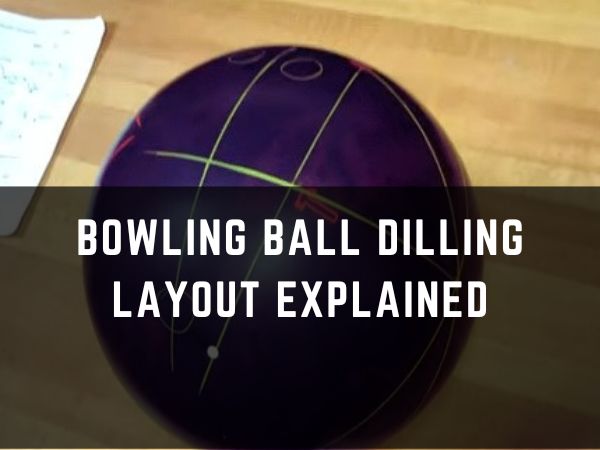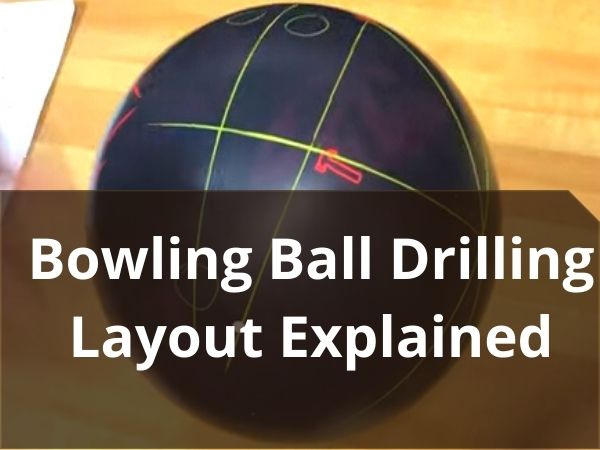Bowling Ball Drilling Layouts Explained! The science behind bowling ball drilling is a bit complicated. But is it too difficult to understand the technical matters of bowling ball layouts? No, it isn’t! To make things easier, you should have proper knowledge of drilling layouts. Here in this article, I have put together some of the layouts suitable for each category.
So before you randomly choose a layout for your bowling ball, make sure you know what you’re doing. The bowling ball drilling layouts explained here will give you a proper idea of how to select the right layout that suits you best. To know more, I would recommend you read to the end.
Bowling Ball Drilling Layouts Explanation!
When getting a bowling ball drilled, the layout is crucial for maximizing performance. Here’s a simple guide to understanding the basics:
1. The Basics
- PAP (Positive Axis Point): The point on the ball that remains stable as it rolls down the lane. Knowing your PAP is essential for accurate drilling.
- Core: The inner part of the ball that affects its dynamics. Different cores influence the ball’s movement.
- Coverstock: The outer layer of the ball. Different materials affect how the ball interacts with the lane.
2. Drilling Layouts
- Standard Layouts:
- Symmetrical Core Layouts: These are easier to drill and adjust. Common layouts include the 3-point, 4-point, and 5-point systems.
- Asymmetrical Core Layouts: These offer more customization and control. The layout focuses on the mass bias (MB) or PSA (preferred spin axis).
- Types of Layouts:
- Pin Up Layout: Places the pin above the fingers, giving the ball a longer skid and a sharper backend reaction. Ideal for dry lanes.
- Pin Down Layout: Places the pin below the fingers, creating an earlier roll and smoother reaction. Good for oily lanes.
- Control Layout: Balances both skid and hook, providing a controlled reaction. Suitable for a variety of lane conditions.
- Aggressive Layout: Maximizes the ball’s hook potential, ideal for heavy oil conditions.
3. Advanced Concepts
- Dual Angle Layout: Combines the drilling angle, the pin-to-PAP distance, and the VAL (Vertical Axis Line) angle to fine-tune ball motion.
- Asymmetrical Ball Layout: Involves setting the pin, mass bias, and CG (center of gravity) to optimize the ball’s reaction.
4. Choosing the Right Layout
- Lane Conditions: Assess whether you usually bowl on dry, medium, or oily lanes.
- Bowling Style: Consider your speed, rev rate, and preferred line.
- Goals: Decide if you want more control, hook, or versatility.
5. Consult a Professional
Always work with a pro shop technician. They can analyze your style and lane conditions to recommend the best layout for your game.
Understanding these basics will help you make informed decisions about your bowling ball drilling layout, enhancing your performance on the lanes.
There are many bowling Ball drilling layouts for bowlers. I have shown some common layouts for you here.
| Drilling Layout | Description |
|---|---|
| Pin Up | The pin is located above the fingers. This layout offers a strong back-end reaction with good length and control. It is suitable for medium oil conditions. |
| Pin Down | The pin is located below the fingers. This layout provides an earlier roll and smoother reaction. It is suitable for heavy oil conditions. |
| Dual Angle | A hole was drilled on the side of the ball to fine-tune the ball’s reaction. It can be used to increase or decrease the ball’s track flare potential. |
| Pin to PAP Distance | Refers to the distance between the pin and the positive axis point (PAP) on the ball. A shorter distance generally produces an earlier roll, while a longer distance provides more length. |
| Pin Buffer | Determines the distance between the pin and the finger holes. A smaller buffer creates a stronger back-end reaction, while a larger buffer offers a smoother, more controlled motion. |
| Balance Hole | A hole drilled on the side of the ball to fine-tune the ball’s reaction. It can be used to increase or decrease the ball’s track flare potential. |
Check AUTOVIC Bowling Ball Quarter Scale Layout Tool On Amazon

These are just a few examples of bowling ball drilling layouts. It’s essential to consult with a professional driller to determine the best layout for your specific needs and playing style.
The drilling layout of a bowling ball is simply the map of where the gripping holes are drilled into a bowling ball. When the pro shop operators drill a layout, they take all the necessary measurements before putting the ball under the drilling machine. Depending on the type of bowling lane you will roll your ball on, the type of bowling style you have, and the track level, the layout will differ. This cancels out any imbalance of your ball and promotes the advantages of perfect rolls, ball motion when it travels down the lane and its pin-hitting ability.
Bowling ball layouts for high-track and low-track players
Now that league and tournament seasons are right around the corner, many of you will get new bowling balls that will need drilling. You are gonna use the advice I’m about to give on the most consistent layouts based on the way you “track” your bowling ball.
High Track:
If you have a high track, the High Track Layout is the best bowling ball drilling layout for you. And if your bowling ball has a symmetrical core, then fantastic! The High Track Layout is just the thing you need.
Low Track
It is important to note that the best layout for a low-track bowling ball depends on the bowler’s style, lane conditions, and desired ball motion. Consulting with a professional ball driller or a coach can help determine the most suitable layout for your specific needs.
Bowling ball layouts for stroker, tweener, and cranker style
Did you know that based on your bowling style, the bowling ball drilling layout differs? Allow me to give you detailed information on that.
Stroker:
Strokers are known to be versatile. They seek accuracy and finesse, but most importantly, they love to control the ball’s motion more than any other type of bowler. This is why many strokers choose any of the ‘control layouts’ to be drilled into their balls. Not only the control layout is the safest option for strokers, but also it is exceptionally compatible with a stroker’s control over the bowling ball. As a bonus, the bowling ball with a control layout determines its precision during the hooking period and its location on the lane.
Bowling balls with Control layouts are great at preventing overreactions despite the lane conditions. This layout helps strokers survive on tougher lane conditions and promotes an aggressive mid-lane motion. This keeps strokers safe from unpredictable hooking on the wrong spot and wrong time, and over-skiing in the oily part of the lane.
Cranker:
Thankfully, crankers have the benefit of more than enough layout options for their bowling balls. The way to choose the layout that will enable more strength to your skid/flip bowling ball. Crankers should always go for a weaker layout. You don’t wanna overpower the ball, do you? With a weaker layout, crankers do not experience aggressive or out-of-bound hooks. Just make sure the layout you choose is perfect for multiple angles. Because this layout slows down the flare potential of a cranker’s bowling ball, the backends won’t blend out too smoothly.
So what kind of weaker layouts will ensure maximum hook? For that, a cranker bowler needs an asymmetrical bowling ball and just select the “Sharper breakpoint layout” (for finer angular breakpoint) or the “Midlane layout” (for a higher rev rate). However, be careful with the mid lane layout bowling ball when the lane starts to dry up.
Tweener:
Because Tweeners are also super versatile, they have a lot of different layouts that work out for them. To know which layout will suit you best you better consult your local pro shop operator and learn their opinion on this matter. Or you can just try out different bowling balls with different layouts to find the right fit for you. Bowling instructors often help in this matter by observing your throws and informing you about the correct layout for you. This will lead to the most suitable bowling ball drilling layout for a tweener-friendly bowling style.
Bowling ball layouts for dry lanes, medium lanes, and heavy lanes
Based on the type of bowling lane conditions, you can use different bowling balls that have different drilling layouts. For example, a low-track drilling layout might not work when the lane starts to break. Similarly, a high-track drilling layout can be a bit too much of drier lane conditions. Hence, changing the bowling balls that have different layouts during a single game is pretty common. Let me give you some suggestions on ball drilling layouts for different lane conditions.
Dry Lanes:
As we all know, dry lanes create the most friction. On light oil lanes, aka dry lanes, you need something that isn’t going to promote overreaction to the friction. Your bowling ball needs to have a layout that is going to retain rotation and tilt. So the rule of thumb would be to use a stronger ball with a weaker drilling layout, and oppositely, a weaker ball with a stronger drilling layout. Make sure the ball isn’t going sideways maintaining the rotation and tilt. When using a weaker bowling ball on the dry lane, make sure the layout is advancing enough angularity.
Medium Lanes:
Your rev rate, speed, tracking, etc depend on the layout you are gonna use on medium lane conditions. This kind of bowling lane is not too dry or too slick. As a result, you get more options for your bowling ball layout. So just choose any layout that suits you best and you feel comfortable bowling.
Heavy Lanes:
For heavier oil patterns, you need a Benchmark or Stronger layout. These kinds of patterns are often a bit tricky to manage. So considering your PAP, axis tilt, rotation, rev rate , and speed (of the hand), go for either a Stronger layout or a Benchmark Layout to become unstoppable. Using the Standard or Benchmark layout options is gonna give you enough skid length with a controllable arc motion that happens in the mid-lane and at the back end of the lane. Using a layout you’re comfortable with will help you read the lanes fast and make sensible decisions for adjustments.
FAQs Of Bowling Ball Drilling Layouts Explained!
What is a bowling ball drilling layout?
A bowling ball drilling layout refers to the specific arrangement of finger and thumb holes in a bowling ball. It influences how the ball reacts on the lane, including its hook potential and overall performance.
Why is the drilling layout important?
The drilling layout affects how the ball interacts with the lane conditions and how it responds to your unique style of play. A proper layout can maximize your scoring potential by providing the right balance of hook and control.
How do I choose the right drilling layout?
Selecting the right drilling layout depends on your individual preferences, skill level, and lane conditions. Consult with a professional pro shop technician who can analyze your game and recommend a layout that suits you best.
What are some common drilling layouts?
There are various drilling layouts, including pin-up, pin-down, and layouts with specific weight blocks, which impact the ball’s roll and hook potential. A technician can help you choose the most suitable one for your needs.
Can I change my drilling layout later?
Yes, you can change the drilling layout on a bowling ball. However, it’s crucial to consult with a pro shop technician, as it may require plugging and re-drilling, which can impact the ball’s performance.
How does the layout affect ball motion?
The layout influences the ball’s RG (Radius of Gyration), differential, and mass distribution. These factors determine the ball’s skid, hook, and roll phases, affecting its overall path and reaction on the lane.
What is the difference between a pin-up and pin-down layout?
A pin-up layout places the pin (top of the weight block) above the fingers, promoting a quicker response and a more aggressive hook. In contrast, a pin-down layout positions the pin below the fingers, providing a more controlled and smooth roll.
Can I use the same layout for all lane conditions?
While some layouts work well on various conditions, it’s advisable to have multiple bowling balls with different layouts to adapt to different lane patterns and oil conditions effectively.
Is there a standard drilling layout for beginners?
There’s no one-size-fits-all answer. Beginners should consult with a pro shop expert who can recommend a layout based on their skill level and goals.
Where can I get my bowling ball drilled with the right layout?
Visit a reputable pro shop with experienced technicians who can assess your needs and provide expert advice on the best drilling layout for your bowling ball.
Conclusion
Do you understand how important it is to use the right drilling layout options to match your ball delivery style? Not every bowler values it equally and ends up blaming the angles. As a result, they don’t drill different bowling balls for experiment purposes. My biggest tip to you would be to try several bowling balls with drilled holes and figure out which layout works for you. You can also consult a professional if you want. Good luck and keep on bowling!

Passionate Bowler and Bowling Enthusiast
Jess Pinelli is a dedicated bowling enthusiast with a deep love for the sport that spans over 6 years. With numerous strikes, spares, and a few gutter balls under hes belt, he has honed his skills on lanes across the country. Pinelli’s journey in the world of bowling has been a remarkable one, from casual weekend games with friends to competitive league play and even a few local tournaments.
Driven by her passion for the game, Pinelli decided to channel her expertise and knowledge into the digital realm, becoming a prolific author on this bowling website. She’s your go-to source for everything bowling-related, from mastering the perfect hook to choosing the right bowling ball and even navigating the world of bowling etiquette.
When she’s not busy writing informative articles or reviewing the latest bowling gear, you’ll likely find Pinellis at her favorite local bowling alley, helping newcomers improve their game or enjoying some friendly competition with fellow bowlers. She firmly believes that bowling is not just a game but a community, and she’s committed to fostering that sense of camaraderie both online and offline.




